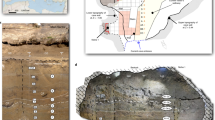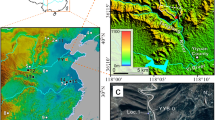Abstract
The human fossil assemblage from the Mladeč Caves in Moravia (Czech Republic)1 has been considered to derive from a middle or later phase of the Central European Aurignacian period on the basis of archaeological remains (a few stone artefacts and organic items such as bone points, awls, perforated teeth)2, despite questions3 of association between the human fossils and the archaeological materials and concerning the chronological implications of the limited archaeological remains4. The morphological variability in the human assemblage, the presence of apparently archaic features in some specimens, and the assumed early date of the remains have made this fossil assemblage pivotal in assessments of modern human emergence within Europe5,6,7. We present here the first successful direct accelerator mass spectrometry radiocarbon dating of five representative human fossils from the site. We selected sample materials from teeth and from one bone for 14C dating. The four tooth samples yielded uncalibrated ages of ∼31,000 14C years before present, and the bone sample (an ulna) provided an uncertain more-recent age. These data are sufficient to confirm that the Mladeč human assemblage is the oldest cranial, dental and postcranial assemblage of early modern humans in Europe and is therefore central to discussions of modern human emergence in the northwestern Old World and the fate of the Neanderthals.
This is a preview of subscription content, access via your institution
Access options
Subscribe to this journal
Receive 51 print issues and online access
$199.00 per year
only $3.90 per issue
Buy this article
- Purchase on Springer Link
- Instant access to full article PDF
Prices may be subject to local taxes which are calculated during checkout


Similar content being viewed by others
References
Szombathy, J. Die diluvialen Menschenreste aus der Fürst-Johanns-Höhle bei Lautsch in Mähren. Die Eiszeit 2, 1–34, 73–95 (1925)
Oliva, M. UISPP XIIe Congres Vol. 2, 207–216 (Institut d'Archéologie, Bratislava, 1993)
Conard, N. J., Grootes, P. M. & Smith, F. H. Unexpectedly recent dates for human remains from Vogelherd. Nature 430, 198–200 (2004)
Svoboda, J. The depositional context of the Early Upper Paleolithic human fossils from the Koněprusy (Zlatý kůň) and Mladeč Caves, Czech Republic. J. Hum. Evol. 38, 523–536 (2000)
Frayer, D. W. Cranial variation at Mladeč and the relationship between Mousterian and Upper Paleolithic hominids. Anthropos 23, 243–256 (1986)
Wolpoff, M. H., Hawks, J., Fayer, D. W. & Hunley, K. Modern human ancestry at the peripheries: A test of the replacement theory. Science 291, 293–297 (2001)
Bräuer, G., Collard, M. & Stringer, C. On the reliability of recent tests of the Out of Africa hypothesis for modern human origins. Anat. Rec. 279A, 701–707 (2004)
Mellars, P. Neanderthals and the modern human colonization of Europe. Nature 432, 461–465 (2004)
Svoboda, J. A., van der Plicht, J. & Kuzelka, V. Upper Palaeolithic and Mesolithic human fossils from Moravia and Bohemia (Czech Republic): some new 14C dates. Antiquity 76, 957–962 (2002)
Smith, F. H., Trinkaus, E., Pettitt, P. B., Karavanić, I. & Paunović, M. Direct radiocarbon dates for Vindija G1 and Velika Pećina Late Pleistocene hominid remains. Proc. Natl Acad. Sci. USA 96, 12281–12286 (1999)
Terberger, T., Street, M. & Bräuer, G. Der menschliche Schädelrest aus der Elbe bei Hahnöfersand und seine Bedeutung für die Steinzeit Norddeutschlands. Archäol. Korrespond. 31, 521–526 (2001)
Henry-Gambier, D. Les fossils de Cro-Magnon (Les Eyzies-de-Tayac, Dordogne): nouvelles données sur leur position chronologique et leur attribution culturelle. Bull. Mem. Soc. Anthropol. Paris 14, 89–112 (2002)
Orschiedt, J. Datation d'un vestige humain provenant de La Rochette (Saint Léon-sur-Vézère, Dordogne) par la méthode du carbone 14 en spectrométrie de masse. Paléo 14, 239–240 (2002)
Trinkaus, E. et al. An early modern human from the Peştera cu Oase, Romania. Proc. Natl Acad. Sci. USA 100, 11231–11236 (2003)
Stringer, C. B. In Hominid Remains: An Update. British Isles and Eastern Germany (ed. Orban, R.) 1–40 (Université Libre de Bruxelles, Brussels, 1990)
Păunescu, A. Paleoliticul şi Mezoliticul din Spaţiul Transilvan 231 (Editura AGIR, Bucharest, 2001)
Hublin, J. J., Spoor, F., Braun, M., Zonneveld, F. & Condemi, S. A late Neanderthal associated with Upper Palaeolithic artefacts. Nature 381, 224–226 (1996)
Serre, D. et al. No evidence of Neanderthal mtDNA contribution to early modern humans. PLoS Biol. 2, e57 (2004)
Schmitz, R. et al. The Neanderthal type site revisited: Interdisciplinary investigations of skeletal remains from the Neander Valley, Germany. Proc. Natl Acad. Sci. USA 99, 13342–13347 (2002)
Wild, E. M. et al. First 14C results from archaeological and forensic studies at the Vienna Environmental Research Accelerator. Radiocarbon 40, 273–281 (1998)
Steier, P. et al. Pushing the precision limit of 14C AMS. Radiocarbon 46, 5–16 (2004)
Bard, E., Rostek, F. & Ménot-Combes, G. A better radiocarbon clock. Science 303, 178–179 (2004)
van Andel, T. H., Davies, W., Weninger, B. & Jöris, B. In Neanderthals and Modern Humans in the European Landscape During the Last Glaciation: Archaeological Results of the Stage 3 Project (eds van Andel, T. H. & Davies, W.) 21–31 (Oxbow, Oxford, 2004)
van der Plicht, J. et al. NOTCAL04-Comparison/calibration 14C records 26–50 cal kyr BP. Radiocarbon 46, 1–14 (2004)
Hedges, R. E. M. & van Klinken, G. J. A review of current approaches in the pretreatment of bone for radiocarbon dating by AMS. Radiocarbon 34, 279–291 (1992)
Petchey, F. in Chemical Pretreatment Methods (ed. Higham, T.) http://www.c14dating.com/pret.html.
DeNiro, M. J. Postmortem preservation and alteration of in vivo bone collagen isotope ratios in relation to palaeodietary reconstruction. Nature 317, 806–809 (1985)
Ambrose, S. H. Preparation and characterization of bone and tooth for isotopic analysis. J. Archaeol. Sci. 17, 431–451 (1990)
Schoeninger, M. J., Moore, K. M., Murray, M. L. & Kingston, J. D. Detection of bone preservation in archaeological and fossil samples. Appl. Geochem. 4, 281–292 (1989)
Acknowledgements
We thank D. Frayer and G. Kurat for comments on an earlier version of this paper. We also thank H. Prossinger and other colleagues for discussions. Furthermore we thank W. Reichmann for the photographic documentation, R. Mühl and A. Walch for technical support, and S. Lehr for his help in sample preparation.
Author information
Authors and Affiliations
Corresponding authors
Ethics declarations
Competing interests
Reprints and permissions information is available at npg.nature.com/reprintsandpermissions. The authors declare no competing financial interests.
Supplementary information
Supplementary Table S1
Radiocarbon ages determined for the animal remains from the Mladec site. (DOC 34 kb)
Rights and permissions
About this article
Cite this article
Wild, E., Teschler-Nicola, M., Kutschera, W. et al. Direct dating of Early Upper Palaeolithic human remains from Mladeč. Nature 435, 332–335 (2005). https://doi.org/10.1038/nature03585
Received:
Accepted:
Issue Date:
DOI: https://doi.org/10.1038/nature03585
This article is cited by
-
The Beginning of the Early Upper Paleolithic in Poland
Journal of Paleolithic Archaeology (2023)
-
Merging morphological and genetic evidence to assess hybridization in Western Eurasian late Pleistocene hominins
Nature Ecology & Evolution (2022)
-
Respiratory adaptation to climate in modern humans and Upper Palaeolithic individuals from Sungir and Mladeč
Scientific Reports (2021)
-
Tracing human mobility in central Europe during the Upper Paleolithic using sub-seasonally resolved Sr isotope records in ornaments
Scientific Reports (2020)
-
The Chronostratigraphy of the Aurignacian in the Northern Carpathian Basin Based on New Chronometric/Archeological Data from Seňa I (Eastern Slovakia)
Journal of Paleolithic Archaeology (2020)
Comments
By submitting a comment you agree to abide by our Terms and Community Guidelines. If you find something abusive or that does not comply with our terms or guidelines please flag it as inappropriate.



